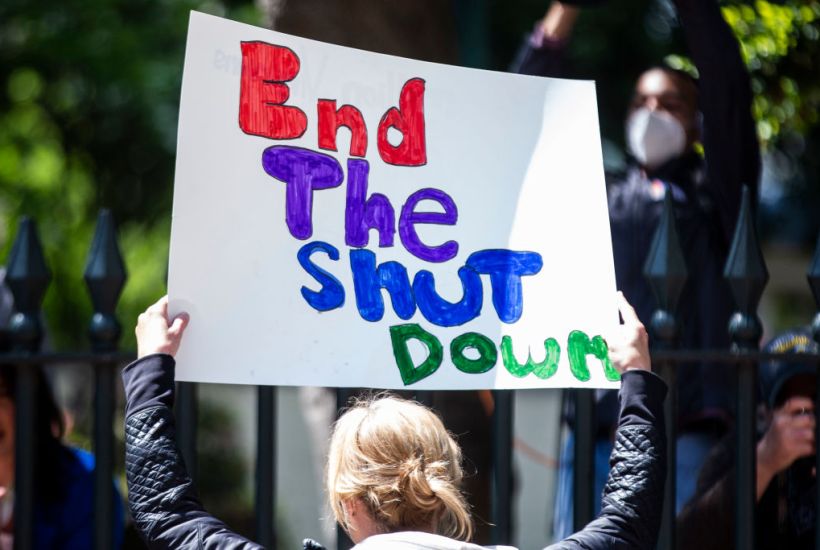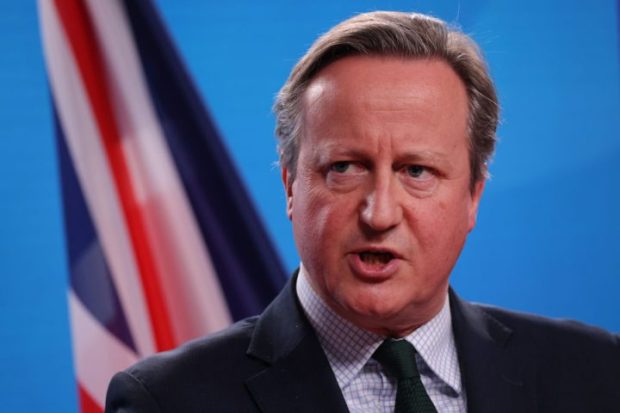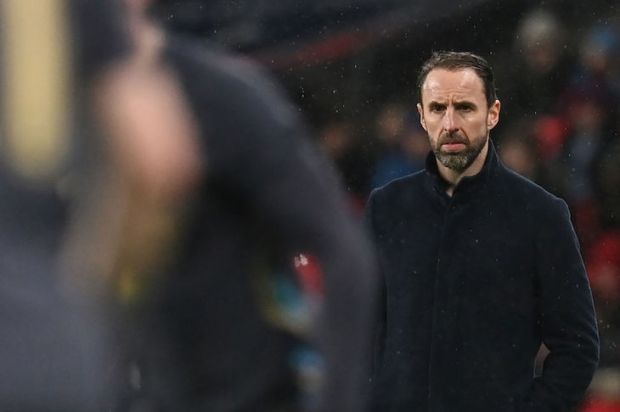One of the more peculiar features of Covid is just how cleanly the crisis has split us down political lines. As a serving Tory councillor, you may assume that my views on masks, lockdown and the virus are predictable. But I’m also a microbiologist and I’m dismayed by the attitudes of some fellow travellers.
Pandemics, particularly ones involving dangerous viruses like this one, are not merely a question of personal freedom but also of collective responsibility. Of course I desperately want a return to normal life. To be frank, however, I do not think that’s going to happen any time soon. Why? Because the virus is simply too dangerous to be left unchecked. I don’t believe a vaccine is imminent (more on that later) — which means, for the foreseeable, we’re going to have to ‘learn to live with this virus’, as the dreary phrase goes. So the question is: how can we best do that?
One suggestion is that we let the virus work its way through the nation’s respiratory tracts so that we reach levels of herd immunity. This, I’m afraid to say, is a fanciful and dangerous notion. There is, in fact, no precedent for natural infections providing lasting herd immunity. It doesn’t happen with measles; we still get outbreaks even with a vaccine. It didn’t happen with smallpox, either, or indeed countless other infectious diseases.
What’s more, we often hear that, because of the common cold, many might already have what’s called cross-reactivity immunity. This means that people are afforded immunity from having had a common cold before. It’s an attractive idea, sure, but it remains nothing more than an airy theory and I would question the wisdom of gambling lives on a mere hypothesis. Does anyone seriously think that the million people worldwide who have died from the virus had not had a common cold before? We’re not even protected against reinfection by those very same cold viruses, so why would we be protected against their lethal cousin?
Those pushing herd immunity are trying to create the impression of a genuine and serious scientific debate where there is none. Quite apart from the fact that it would cost an extra few hundred thousand lives to achieve a sufficient level of post-infection immunity, there’s an increasing body of evidence that any such immunity wanes rapidly. Indeed, just this week, doctors in Arizona reported a proven reinfection in a 25-year-old man and an 89-year-old Dutch woman died after reinfection; there have been a handful of other cases too. Yes, the numbers are very low and it’s entirely possible that reinfection will be a rare phenomenon, but equally we could be seeing the first handful of cases in very many more to come. If that dwindling immunity renders most people susceptible to the virus again after, say, 12 to 18 months, we simply won’t know for a little while yet.
Another argument that is popular is that we could simply shield our elderly and vulnerable. It’s a nice idea, but one lacking any realistic and practical way forward. As a former cancer patient who has undergone chemotherapy, I just don’t see how it could be possible. Those who are vulnerable, by definition, regularly require increased medical attention and outside support. How are they supposed to rely on the help of doctors, carers, support staff, friends and family without coming into contact with potential virus carriers? Would we have set shopping times for certain age groups? Or certain segments of society? And what about the increased risk to BAME communities? How on earth would it work pragmatically?
What’s more, we know that rising infection levels in the young has a knock-on impact in every other age group. Dr Duncan Robertson at Loughborough University has produced a number of interesting heat maps which neatly show how infection has bled into older age groups as numbers have increased. It’s not simply a case that we can lock-away huge chunks of the retirement age population.

Credit: Dr Duncan Robertson, a modelling and policy academic at Loughborough University and a fellow of St Catherine’s College, Oxford
At the heart of these arguments is the idea that the virus is not dangerous. But, make no mistake: it really is. It is common to hear the argument that ‘It’s just a bad cold’ and ‘it’s no more dangerous than flu’. Not since 1918 has a PM been brought so low by a case of flu and Spanish flu was hardly typical. During the first eight months of this year, flu and pneumonia were the underlying cause of 14,013 deaths in England and Wales (a mere 394 of those were confirmed as cases of flu and although a lot of the pneumonia deaths were actually caused by unverified flu infections, many will not have been), yet Covid-19 accounted for 46,168 fatalities, more than the ONS has ever recorded for flu and pneumonia in the first eight months of any year. For reference, that’s about 40 times the number of deaths on the roads over an averaged eight-month period.
It’s also become common currency to point to 2017/18 excess winter deaths of 50,000 and say that Covid is no worse than a bad flu year, but according to Public Health England, there were only about 16,000 recorded flu deaths in England over that period. Many of those excess deaths will have been caused by things like circulatory diseases.
Few diseases are as insidiously contagious as Covid-19 or create such a lightning strike burden on our healthcare infrastructure, which is why we ended up in lockdown. Remember ‘Stay home, protect the NHS, save lives’? Well, the middle bit was the operative part: if the NHS had been able to cope with the numbers of people needing care, there would not have been a lockdown and that’s what will determine future lockdowns too. We are starting to see again in the North just how dangerous the virus is, as hospitals begins to come under pressure; Liverpool’s intensive care units are currently at 95 per cent capacity.
Yet the way that so many intelligent people talk about it, you’d be forgiven for thinking that every hospital in the country had a spare ten per cent capacity just lying empty for such occasions. And what do the anti-lockdown brigade think will happen to other NHS services if the virus is left unchecked? The NHS wasn’t overwhelmed last time because most hospitals cancelled their surgeries and routine clinics — everything became Covid-19 orientated.
The painful truth is that we are unlikely to get a vaccine any time soon. The over-optimistic predictions of one being ready by September were a failure of expectation management. Our media rightly report Russian claims of a vaccine produced at pace with tongue in cheek. But simultaneously we see churned out soft-focus, hostage-to-fortune features about UK efforts that don’t explain the slim chances of success.
Similarly, when we hear politicians and TV doctors pronounce that clinical trials are ‘going well’, we are being misled; the trials are blind, they don’t know how well they’re going. If religion was the opium of the people in the 19th century, assurances of a syringe full of effective vaccines arriving soon seem to be their sedative of choice in 2020. I’m concerned that this hubris is encouraging people to think that their saviour will arrive imminently, when it’s unlikely. Initial predictions of a vaccine by September slipped to the end of this year, now Boris Johnson suggests that life may not return to normality until the end of 2021.
Vaccine trials fail more often than not. The initial experimental work on the Oxford vaccine, done in animals, was not viewed by many of my fellow scientists as the unqualified success that the media breathlessly reported. Even when clinical trials get to phase three, they can and regularly do fall at the final fence. I once worked on a project to identify potential vaccines for the MRSA ‘superbug’. A major pharmaceutical company took forward one of the candidates and all went well until it reached phase three. There, it was discovered that the vaccine, which had been intended to reduce the risk of post-surgical infection, instead increased the likelihood of death by over 400 per cent. So it came as no surprise when US regulators recently threw a spanner into the Oxford vaccine’s works by halting booster doses for American volunteers while the side effects are investigated. This may prove to be a significant blow to the trial but it’s typical for these ‘bumps in the road’ that happen.
Of course, lockdowns cannot defeat the virus, but they can apply the brakes and stop increasing numbers of people turning up at hospital struggling to breathe. It’s become easy to mock professor Neil Ferguson. Outwardly he may appear like a caricature of an academic: metropolitan, elitist, unwilling to live by his own rules. Politically, I am on the other side of the fence — but not when it comes to his science. Despite a lot of snipes at his modelling, his group’s projections were broadly right. We’ll never know how accurate the Imperial death predictions were because lockdown stopped things from getting that bad.
With infections and hospitalisations on the rise, we face the challenge now to stop history repeating itself. Restaurants and pubs were the thing I missed most during lockdown but I fear we’ll end up being denied them again right across Britain, rather than just in certain areas. While I fail to see any justification in the 10 p.m. curfew, there is a growing body of evidence from the US that bars and restaurants are drivers of infections. The Eat Out to Help Out scheme, while well intentioned, now looks unwise, as does the government’s July plan for ‘a more significant return to normality’ by Christmas. Just like promises of a vaccine, these schemes encouraged people to think that, while it might not all be over just yet, we’re almost there, and that we can relax and enjoy ourselves. This is now clearly wrong.
To make progress and stop the country getting into a situation where hospitals are on the brink of collapse, people need clarity and brutal honesty. A clear, understandable national mission statement that explains the objectives of restrictions — beyond mere testing statistics — would help. As would dropping the hyperbole about eliminating the virus.
We also need to be honest that the virus is going to be with us for some time and that there will be a degree of unfortunate death — the government should set targets for the tolerable level of infections that will percolate through the community and hospital admissions, similar to the Treasury’s inflation target. Upon breaching these targets, the public should expect a reflexive adjustment of restrictions with social settings of all kinds potentially affected; as with monetary policy, special pleading would need to be ignored. We live with some risk every day — we can’t live risk free for as long as this coronavirus is around.
I had hoped the tier system that’s just been introduced might go some way towards this, but it is not as black and white as I’d wanted — there appear to be substantial grey areas at the boundaries of the tiers and really substantial differences in the numbers of infections within the tiers. This goes to the heart of failure of the government to take the public with them when they impinge on their lives.
It’s true that ministers should not hide policy decisions behind the deflecting tactic that they are entirely ‘led by the science’. But, to borrow part of another Conservative slogan, the country needs a long-term clinical plan. Like the economy, the future course of this pandemic will be uncertain and will develop in ways that we cannot entirely predict. While it’s important to chase off the snake oil merchants, we must not forget that the real danger comes from the snake itself.
Got something to add? Join the discussion and comment below.
Get 10 issues for just $10
Subscribe to The Spectator Australia today for the next 10 magazine issues, plus full online access, for just $10.




















Comments
Don't miss out
Join the conversation with other Spectator Australia readers. Subscribe to leave a comment.
SUBSCRIBEAlready a subscriber? Log in